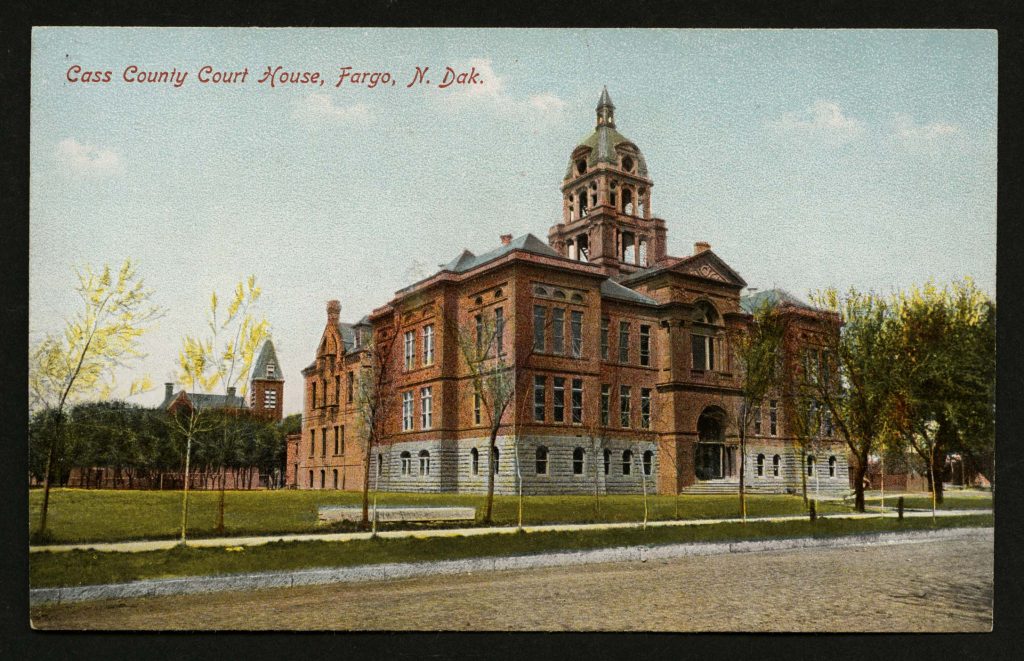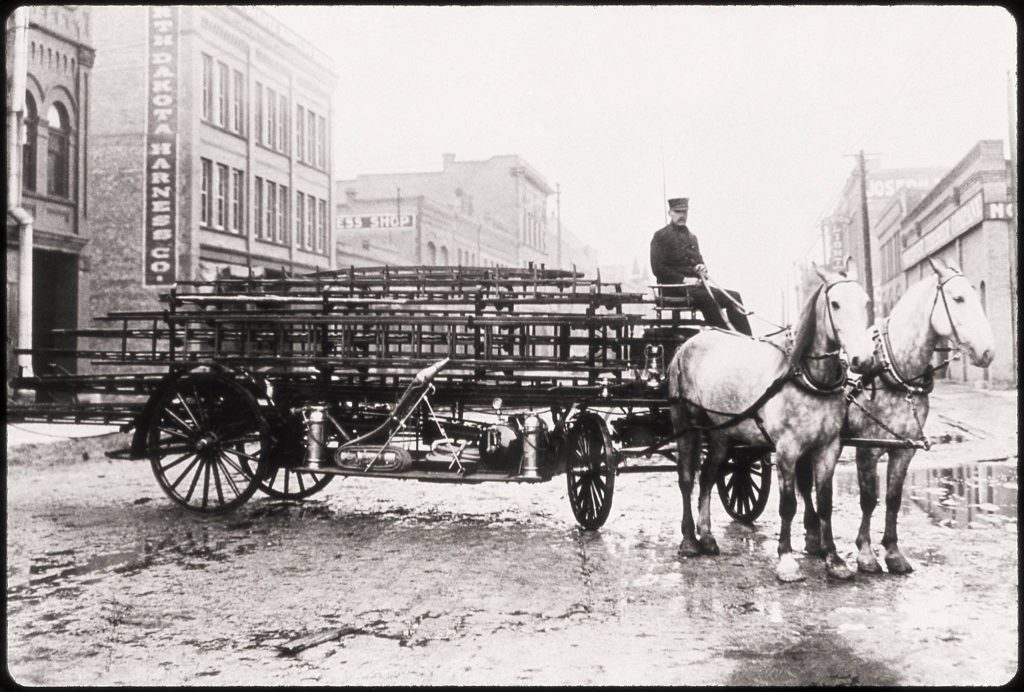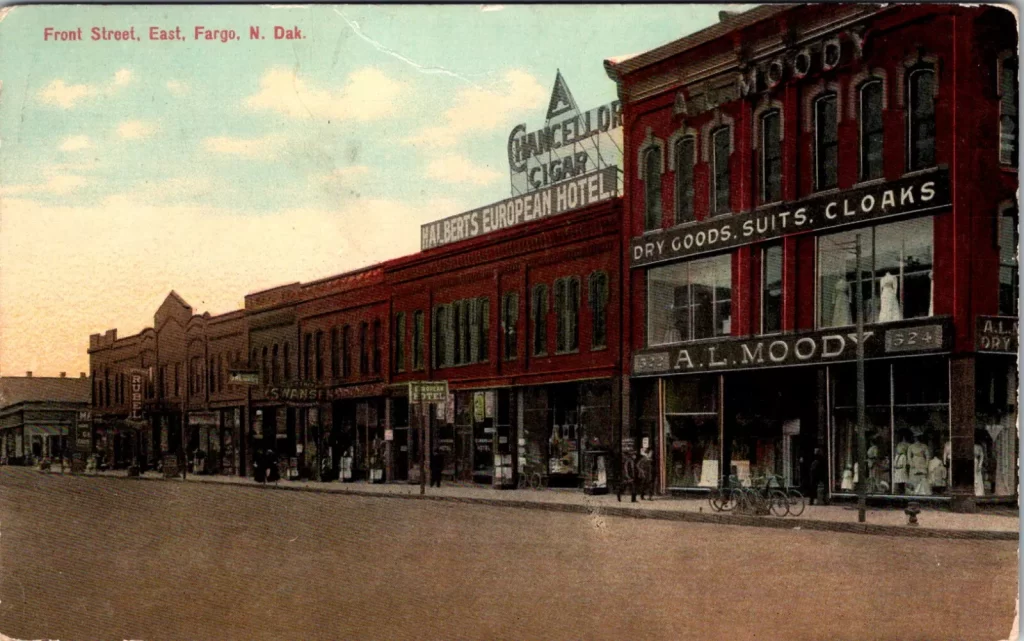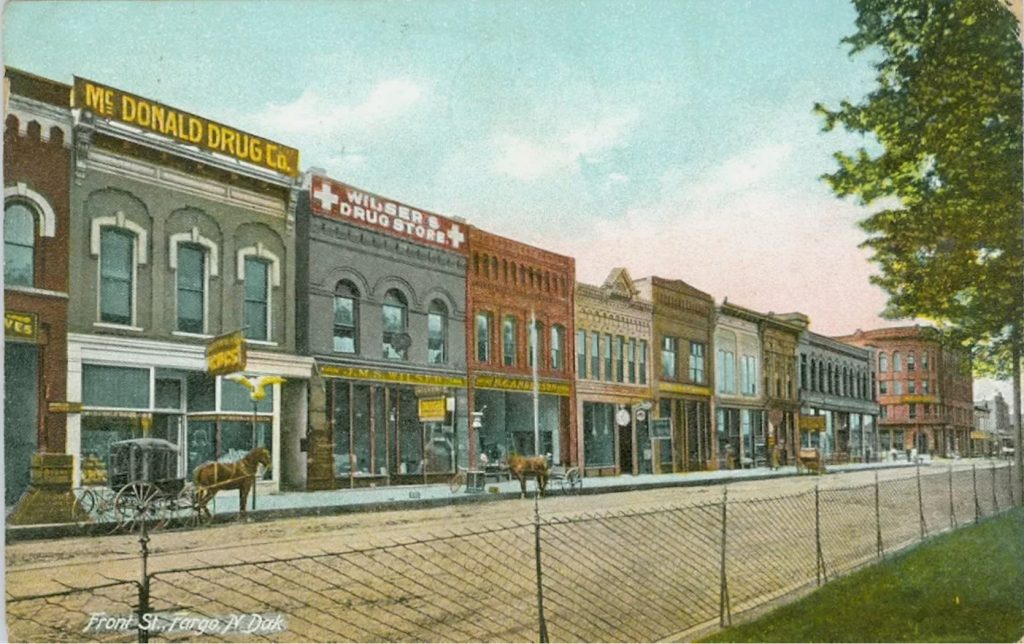This article provides a vibrant snapshot of Fargo, North Dakota, in the early 1900s, highlighting its impressive growth and prosperity. The author begins by painting a picture of a city booming with new construction, “wealth and solidity” evident in its architecture and infrastructure. The piece then delves into specific examples of Fargo’s progress, citing the impressive growth of its financial institutions, the success of local businesses (particularly in the farm implement sector), and the significant increase in post office revenue. The source concludes with a detailed account of Fargo’s newspapers, its agricultural society, and a glowing review of the Commercial Club’s role in the city’s advancement. Through this detailed portrayal of Fargo’s achievements, the author effectively argues for its significance as a burgeoning economic and cultural center in the early 20th century.
The population of Fargo, as shown by the last census of 1905, was 12,500. At the present writing, 1909, it is estimated to be in the vicinity of 14,500. The buildings, public, business, and private, convey the impression of wealth and solidity; wealth by the attractiveness of their architecture, and solidity by their substantial build. The structures in the business sections are of brick, as a rule, and from two to five stories high. The diversity of architecture gives the visitor something to think about, and all in all, he is pleased by appearances. The business streets have sidewalks of cement blocks or asphalt, while the streets are paved with cedar blocks. There are many imposing buildings, especially the implement houses; one of the largest has a floor space of 100,000 square feet with 30,000 square feet of platform room.
Among public buildings, the United States court building, occupied jointly by the courts, post office, and land office, is an ornate structure of cream brick and cost $90,000. The business of the various departments occupying the building grew beyond the expectation of the builders, and an addition was built as large as the original building, for which Congress readily gave $100,000. The county has a fine courthouse, constructed of stone in 1906 at a cost of $200,000. There are many handsome business blocks, a list of which would make a long roll.
While the business and public buildings of the city are worthy of a prosperous community, it is in the residences of the citizens, many of whom came when the city was in its infancy and have gathered competency through their energies and intelligence.
Fargo will compare with any city twice its size in respect to pretty homes. The domestic architecture applied to the city cannot be described in detail. Even in the humbler homes may be seen many instances of unusual taste.
Numerous church edifices furnish places of worship for the different church organizations, and Fargo is the See city of the Roman Catholic and Protestant Episcopal churches.
The city is well provided with means of protection against loss by fire, the volunteer fire department having been superseded by a paid department, which is furnished with a first-class engine and other apparatus and has gained a degree of efficiency that has been the means of securing a material reduction of insurance rates by the different companies doing business in the city.
North Dakota has a drastic prohibition law which is strictly enforced in Fargo. Prohibition is a part of the constitution of the state, and that cannot be changed except by means of a constitutional convention, or by amendment to the constitution. If by an amendment, one legislature must propose it and the next, meeting two years later, must submit the matter to a vote of the people to be taken still two years later. Therefore, the question must come before the people at three successive elections, and the agitation must cover a period of six years. The liquor element has never been strong enough in the legislature to submit the question to a vote of the people, and each attempt has been followed by legislation intended to strengthen the law. The sentiment for prohibition has in the meantime been growing, and the law has been generally enforced throughout the state.
Fargo today is a great little city—the commercial, educational, religious, social, and political center of the state. It is constantly growing, and almost every item of statistics by which comparisons may be made of one year with another shows a steady, rapid, and natural growth. The clearing house transactions of 1905 reached the enormous sum of $32,750,000, which amount is in excess of that of any other city of a similar population. This enormous sum was largely due to the consolidation of the Fargo banks. The clearing house transactions from April 1st, 1908, to April 1st, 1909, were $32,212,280.09. The volume of farm implement business in 1906 was more than $8,000,000, being greater than that of any other city in the world. The post office receipts at Fargo in 1888—twenty years ago—were $21,255.29. The receipts for 1906 were $67,051.20; for 1907, $86,418.98; for 1908, they were $99,657.60. The wholesale and jobbing interests are rapidly increasing and also exceed in volume those of any other city the size of Fargo. Not only is the business of each individual wholesale house increasing, but additional houses are being established, and many of the largest manufacturing and jobbing houses of other cities have established branch houses here, a fact that proves beyond a doubt the importance of Fargo as a commercial point.
Banks and Bankers
The history of banking in North Dakota has been one of steady growth and prosperity, beginning with the original bank known as the Harwood & Hummel Bank, which opened for business in Fargo in the fall of 1877 as a private bank, on down through the succeeding years until the present time (1909) we find 568 banking institutions in the state divided as follows: 130 National Banks, 435 State Banks, and three Trust Companies. That this remarkable growth has been along the line of conservative, intelligent methods is shown in the fact that during the so-called panic of 1907, probably the worst ever experienced by the bankers of the country, not a single bank in the state failed, and only one bank was closed temporarily.
The First National Bank of Fargo was organized in 1878 by Evan S. Tyler, N. K. Hubbard, M. B. and George Q. Erskine, and E. B. and E. C. Eddy with a capital stock of $75,000. E. B. Eddy was the first President and E. C. Eddy was the first Cashier; after the death of Mr. E. B. Eddy, E. C. Eddy was made President and C. E. Robbins Cashier; subsequently M. B. and George Q. Erskine served the bank as President, George Q. Erskine being succeeded by J. W. Smith, at which time Honorable L. B. Hanna was made Vice President and S. S. Lyon, Cashier. The bank did a flourishing business for many years under the latter management until they sold out to the Red River Valley National Bank, January 1st, 1906.
About the time of the organization of the First National, a private institution called the Bank of Fargo was started by J. F. Hummel and A. J. Harwood; this institution subsequently came under the control of Charles Sweatt and H. F. Miller and under their management became an important financial institution which was subsequently re-organized as the Citizens’ National Bank, but failed in 1896.
The Red River Valley National Bank was organized in 1881 with L. S. Follett as President, Stephen Gardner, Vice President, and L. W. Follett, Cashier. Capital stock, $100,000. J. W. Von Neida succeeded L. S. Follett as President, he being succeeded by R. S. Lewis in 1901, when Mr. Von Neida was made Cashier; F. A. Irish had served the bank as assistant Cashier ten years previous to this time and was made Cashier in 1905. Mr. Lewis had been connected with the institution for many years prior to being made President, having held nearly every position. He was succeeded as President by Robert Jones in 1904, when E. J. Weiser was made Vice President. The Red River Valley National and the First National were consolidated January 1, 1906, with Robert Jones as president, E. J. Weiser, vice president, and F. A. Irish, cashier.
At the present writing, 1909, L. B. Hanna is president; E. J. Weiser, vice president; F. A. Irish, cashier; L. R. Buxton, assistant cashier; S. H. Manning, auditor. The present capital and surplus are $325,000, and the deposits $3,000,000. The directors are Thomas Baker, Jr., Peter Elliott, L. B. Hanna, F. A. Irish, James Kennedy, R. S. Lewis, Peter Luger, J. A. Montgomery, A. L. Moody, W. A. Scott, J. W. Smith, J. S. Watson, and E. J. Weiser.
The Merchants State Bank was organized in August, 1890, with Hon. B. F. Spalding as president and L. S. Champine as cashier, the capital stock being $50,000, which was increased to $100,000 in 1893. Hon. John D. Benton was made president in 1894 and N. A. Lewis vice president. Mr. Lewis was made president in 1898. H. W. Gearey was made cashier in 1896 and promoted to the vice presidency in 1906, S. S. Lyon succeeding him as cashier.
The institution was made a national bank in April, 1906. Its present officers are: President, N. A. Lewis; vice president, O. G. Barnes; vice president, H. W. Gearey; cashier, S. S. Lyon; directors, J. D. Benton, Stewart Wilson, W. P. Porterfield, S. S. Lyon, W. F. Ball, Stevenson Dunlop, O. G. Barnes, Alex Stern, H. W. Gearey, N. A. Lewis; and its capital $100,000 and surplus $50,000.
The Northwestern Mutual Savings and Loan Association was started in June, 1893, by Herbert L. Loomis and R. A. Shattuck, teller and cashier, respectively, in the Citizens National Bank; there was no capital paid in. Their assets amounted to $2,513.
In 1896 Mr. Loomis was made secretary and treasurer and assumed the actual management, with assets amounting to $30,458, and on June 30, 1906, they were $718,961, and at the present writing, 1909, they are $1,100,000.
The present officers and directors are as follows: President, W. C. Macfadden; vice president, George B. Runner; general attorney, W. B. Douglas; secretary and treasurer, Herbert L. Loomis; assistant secretary and treasurer, H. H. Wooledge; directors, W. C. Macfadden, A. L. Wall, W. B. Douglas, L. B. Hanna, George B. Runner, W. O. Olsen, H. L. Starling, Herbert L. Loomis.
The Fargo National Bank was organized in 1897 with Martin Hector as president; O. J. de Lendrecie, vice president; and W. C. Macfadden, cashier, with a capital stock of $50,000. Mr. Macfadden resigned as cashier in 1904 and was succeeded by George E. Nichols. The present officers are: President, Martin Hector; vice president, O. J. de Lendrecie; cashier, G. E. Nichols; and the present directors are Martin Hector, O. J. de Lendrecie, G. E. Nichols, John S. Watson, and S. G. Wright.
The Northern Trust Company was organized on February 1, 1902, with a capital stock of $100,000. Ed Pierce, president; George H. Hollister, vice president; B. I. Keating, secretary; H. P. Beckwith, treasurer.
Its present officers are G. H. Hollister, president; J. G. Thompson, vice president; B. G. Tenneson, second vice president; B. I. Keating, secretary; P. W. Clemens, assistant secretary; H. P. Beckwith, treasurer.
The Commercial Bank was organized in June, 1904. W. C. Macfadden, president; Frank C. Gardner, vice president; and H. C. Plimpton, cashier. Capital stock, $50,000.
The Commercial Club of Fargo
By C. G. Baernstein, Secretary
Incorporated August 14, 1902, by the following named gentlemen: R. S. Lewis, L. B. Hanna, W. D. Sweet, J. C. Hunter, A. L. Wall, H. C. Plumley, T. A. Whitworth, W. J. Price, H. Harrington, Geo. W. Wasem, S. G. Wright, C. A. Eberhart, Morton Page, W. C. Macfadden, and H. W. Gearey.
On September 12, 1902, the following officers were elected for this organization:
- President: R. S. Tyler
- First Vice President: A. L. Wall
- Second Vice President: J. C. Hunter
- Secretary: E. S. Tyler
- Treasurer: W. C. Macfadden
The purposes for which the corporation is formed are as follows:
To encourage and promote the commercial and manufacturing interests of the city of Fargo; to foster and encourage through social intercourse a public spirit and feeling of loyalty to the city; to promote the growth, development, and beauty of the city; to assist in making it a city of homes; to develop the jobbing and wholesale interests of the city; to encourage manufacturing within its limits; to advise and assist in municipal improvements looking to the accomplishment of the aims heretofore set forth; to own real estate on which a home may be built for said club and to establish such social features as will assist in carrying out the aims of the corporation.
R. S. Tyler held office as president for a short time, as his death occurred on January 8th, 1903. On June 2, 1903, the following officers were elected: President, J. C. Hunter; first vice president, A. L. Wall; second vice president, L. B. Hanna; secretary, George H. Phelps; treasurer, W. C. Macfadden. J. C. Hunter served as president until June 13, 1905, when R. S. Lewis was elected and has held the position to this time.
This club has at all times been in good financial condition and has contributed very largely to the success and welfare of this city, as well as the state at large, having succeeded in procuring railroad rates and other vital purposes for the prosperity of the same.

The Press
William G. Fargo, having offered a premium of $500 for the establishment of a newspaper in Fargo, to be called the Fargo “Express,” Messrs. A. H. Moore and Seth Boney, in order to secure the bonus, started a paper under that name, the first issue being printed June 7, 1873, on the press of the Glyndon “Gazette.” The paper appeared regularly until the end of the year, but on account of it not being printed in Fargo, the bonus was withheld, and was subsequently attained by Messrs. G. J. Keeney and A. J. Harwood, who purchased and installed a printing press, and the first paper, “The Fargo Express,” actually printed in Fargo, came out January 1, 1874. The office of the Fargo “Express” stood in the middle of Broadway at the intersection of Northern Pacific avenue, and while the paper was not a financial success, it left its mark on the affairs of Fargo, and will be remembered as a potent factor in the early history of the city and state.
During the same year the Fargo “Mirror” was established by Evan S. Tyler. Both these papers were subsequently purchased by E. B. Chambers, publisher of the Glyndon “Gazette,” who moved his printing office to Fargo, merged them under the name of the Fargo “Times,” which he published for several years. In 1878 the Fargo “Times” passed into the possession of Major A. W. Edwards and Dr. J. B. Hall, who changed its name to that of the “Republican.” On November 17, 1879, the “Argus” was established by Major A. W. Edwards.
H. C. Plumley became associated with Major Edwards in 1881 and they continued the publication of the “Argus” until 1891.
After the “Argus” passed out of the hands of Major Edwards and into the control of J. J. Hill, it was managed successively by George K. Shaw, for a short time, then by Gage & Irons, later passing to the management of a syndicate headed by K. D. Hoskins as business manager, who had purchased it of J. J. Hill. In 1897 A. B. McDonald purchased the “Argus” and conducted it for about a year, at which time he disposed of it to Messrs. Hall, Lavalle and F. G. Jordan, who managed it for about six months, at the end of which time it was turned back to A. B. McDonald, who sold it to J. J. Jordan, who consolidated it with the “Morning Call,” which he had established in 1898. Mr. Jordan owned and conducted the paper from that date until March 15, 1909, when he sold it to the News Publishing Company.
The “Morning Call” was established in 1898 by J. J. Jordan, who edited and published it until March 15, 1909, when it was sold to the News Publishing Company, who merged it with the “Daily News” under the title of Fargo “Daily News,” “Morning Call” and Fargo “Daily Argus.”
“The Forum” was established in 1891 by Major A. W. Edwards and H. C. Plumley, and in 1894 it absorbed the “Republican” and it has since gone under the name of the Fargo “Forum and Daily Republican,” as a daily and weekly paper. It was incorporated March 19, 1900, under the title of The Forum Printing Company; H. C. Plumley president and general manager.
The Edwards brothers, sons of the late Major Edwards, have grown up in the business in this city and are entitled to full credit for much of the success of the “Forum.”
“Fram,” Norwegian Weekly. “Red River Posten,” the first Norwegian newspaper, was established at Fargo in the spring of 1879 by M. Wisenberg. It was continued under different managements until 1883, when it was sold to Julseth & Myhra, and merged with the “Norske Amerikaner.” This paper was continued until the fall of 1884, when it was sold at sheriff’s sale and taken to St. Paul and turned over to “Nordvesten.”
On January 24, 1885, P. T. Julseth got out the first issue of “Fargo Posten” and he continued to publish it until the fall of 1888, when the paper was sold first to a syndicate and afterward to Glaus A. Glasrud, who continued it until in April, 1889, when he sold it to A. A. Trovaten.
A. A. Trovaten went into partnership with P. T. Julseth as publishers of “Fargo Posten” in April, 1887, but sold out his interest to Mr. Julseth a year later, and in June, 1888, commenced to publish “Vesten.” This he afterward merged with “Fargo Posten” and “Nordlyset” (for a time published by Mr. Bierley in Grand Forks) and called it “Dakota.” This paper was published by him until April 1, 1895, when he sold it to Stavnheim and Henning. Henning sold his interest to A. Norman, and “Dakota” was published by this firm until 1898, when a consolidation took place between “Fjerde Juli,” published at Grand Forks; “Rodhuggeren,” published at Fergus Falls, and “Dakota,” published at Fargo, and “Fram” was established, and was published by a co-partnership consisting of O. E. Hagen, of Crookston; Torkel Oftelie, of Fergus Falls, and A. E. Norman, L. Stavnheim, I. H. and O. H. Ulsaker, of Fargo, until July, 1903, when A. A. Trovaten bought out a large interest in the paper and formed a corporation of which he became president and manager. A. A. Trovaten is still in control, as manager and editor.
Cass County Agricultural Society
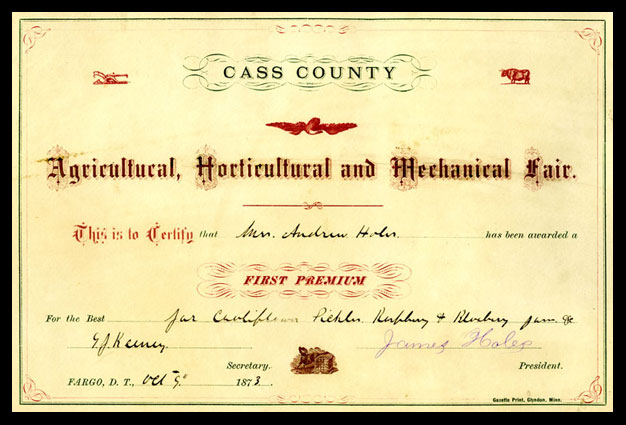
It was during the fall of 1873 that this society was organized, with James Holes, president. In October a fair was held in a building occupying the present site of the European hotel. Quite a remarkable exhibit was made in the way of agricultural products, mostly from the gardens of James Holes, Harry Fuller, A. McHench, Wm. H. Leverett, S. V. Hoag and Peter Englebretson. There was also quite a display of vegetables, especially of corn, from the gardens of Charles Grant and Charles Bottineau, on the Pembina river, as well as from the gardens of Ft. Pembina; also from the gardens at the British post across the line in Manitoba, at that time garrisoned by troops of the British army. The Northern Pacific Railroad Company availed itself of this opportunity to advertise the Red River valley.
North Dakota State Fair Association, of Fargo, is known by “State Fair Association of Fargo” and was created in 1905. It having acquired a clear title to not less than seventy acres of land. It has invested more than $5,000 given it by the state of North Dakota in permanent improvements for the year 1908, and since the association’s first report, December 21, 1906, it has offered and expended in premiums more than the sum of $5,000 required to be expended. The corporation shows that amounts, greatly in excess of the state appropriations for premiums, have been returned to the people as a reward for their industry in enhancing the state’s resources.
Additional History
Source
C.F. Cooper & Company, History of the Red River Valley, Past And Present: Including an Account of the Counties, Cities, Towns And Villages of the Valley From the Time of Their First Settlement And Formation, volumes 1-2; Grand Forks: Herald printing company, 1909.

